Christmas ornament
.jpg)

Christmas ornaments are decorations (usually made of glass, metal, wood, or ceramics) that are used to festoon a Christmas tree. Ornaments take many different forms, from a simple round ball to highly artistic designs. Ornaments are almost always reused year after year rather than purchased annually, and family collections often contain a combination of commercially produced ornaments and decorations created by family members. Such collections are often passed on and augmented from generation to generation.
Santa Claus is a commonly used figure. Candy canes, fruit, animals, snowmen, angels and snowflake images are also popular choices.
Lucretia P. Hale's story "The Peterkins' Christmas-Tree"[1] offers a short catalog of the sorts of ornaments used in the 1870s:
There was every kind of gilt hanging-thing, from gilt pea-pods to butterflies on springs. There were shining flags and lanterns, and bird-cages, and nests with birds sitting on them, baskets of fruit, gilt apples, and bunches of grapes.
The modern-day mold-blown colored glass Christmas ornament was invented in the small German town of Lauscha in the mid-19th century.[2]
Bauble
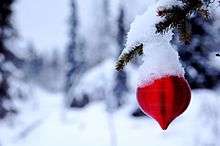
A bauble is a spherical decoration commonly used to adorn Christmas trees. The bauble is one of the most popular Christmas ornament designs, and they have been in production since 1847. Baubles can have various designs on them, from "baby's first Christmas" to a favorite sports team to a simple shiny sphere of a single color.
Invention

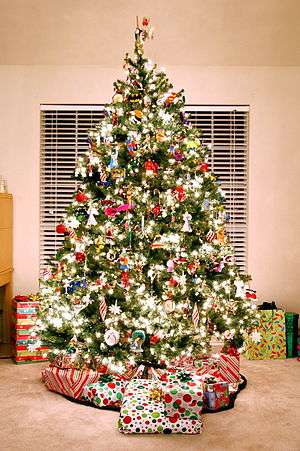
The first decorated trees were adorned with apples, white candy canes and pastries in the shapes of stars, hearts and flowers. Glass baubles were first made in Lauscha, Germany, by Hans Greiner (1550-1609) who produced garlands of glass beads and tin figures that could be hung on trees. The popularity of these decorations grew into the production of glass figures made by highly skilled artisans with clay molds.
The artisans heated a glass tube over a flame, then inserted the tube into a clay mold, blowing the heated glass to expand into the shape of the mold. The original ornaments were only in the shape of fruits and nuts.
After the glass cooled, a silver nitrate solution was swirled into it, a silvering technique developed in the 1850s by Justus von Liebig. After the nitrate solution dried, the ornament was hand-painted and topped with a cap and hook.[3]
Export
Other glassblowers in Lauscha recognised the growing popularity of Christmas baubles and began producing them in a wide range of designs. Soon, the whole of Germany began buying Christmas glassware from Lauscha. On Christmas Eve 1832, a young Victoria wrote about her delight at having a tree, hung with lights, ornaments, and presents placed round it.[4] In the 1840s, after a picture of Victoria's Christmas tree was shown in a London newspaper decorated with glass ornaments and baubles from her husband Prince Albert's native Germany, Lauscha began exporting its products throughout Europe.
In the 1880s, American F. W. Woolworth discovered Lauscha's baubles during a visit to Germany. He made a fortune by importing the German glass ornaments to the United States.
Mass production
The first American-made glass ornaments were created by William DeMuth in New York in 1870. In 1880, Woolworth's began selling Lauscha glass ornaments. Other stores began selling Christmas ornaments by the late 19th century and by 1910, Woolworth's had gone national with over 1000 stores bringing Christmas ornaments across America. New suppliers popped up everywhere including Dresden die-cut fiberboard ornaments which were popular among families with small children.
By the 20th century, Woolworth's had imported 200,000 ornaments and topped $25 million in sales from Christmas decorations alone. As of 2009, the Christmas decoration industry ranks second to gifts in seasonal sales.[3]
Post World War II
After World War II, the East German government turned most of Lauscha's glassworks into state-owned entities, and production of baubles in Lauscha ceased. After the Berlin Wall came down, most of the firms were reestablished as private companies. As of 2009, there are still about 20 small glass-blowing firms active in Lauscha that produce baubles. One of the producers is Krebs Glas Lauscha, part of the Krebs family which is now one of the largest producers of glass ornaments worldwide.
Modern baubles
Although glass baubles are still produced, as expensive good quality ornaments often found at markets, baubles are now frequently made from plastic and available worldwide in a huge variety of shapes, colors and designs. There are a large number of manufacturers producing sophisticated Christmas glass ornaments in Poland and millions of glass blown Christmas ornaments are made year-round in Tlalpujahua, Michoacan, Mexico and exported to Spain, New Zealand and France. [5]
Types
- Christmas tree ornaments
-
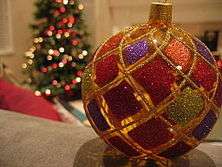
Christmas bauble, or ball ornament
-

Blue Christmas ornament
-
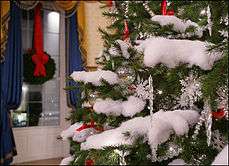
Christmas tree snow
-
Christmas ornament snowman
-
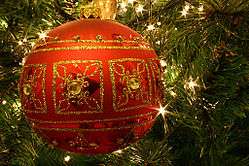
Red and gold ornamented Christmas bauble
-

Christmas Angel decoration
-
A handcrafted Christmas ornament
-

Christmas Bear
-
.jpg)
Giftbearer
-
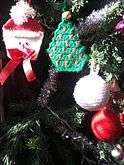
Hand-crafted Xmas baubles and ornaments in crochet
-

Santa Claus and teddy bear
-
.jpg)
Christmas tree top decoration
-

Giftbearer
-
Christmas owl
-

Free blown glass large hand painted Christmas bauble
See also
| Wikimedia Commons has media related to Christmas baubles. |
Notes
- ↑ Lucretia P. Hale, The Peterkin Papers. 1960; Houghton Mifflin
- ↑ German Christmas Ornaments
- 1 2 Ace Collins Stories Behind the Great Traditions of Christmas. 2003; Zondervan.
- ↑ The girlhood of Queen Victoria: a selection from Her Majesty's diaries. p.61. Longmans, Green & co., 1912. University of Wisconsin
- ↑ Tlalpujahua, town of eternal Christmas
